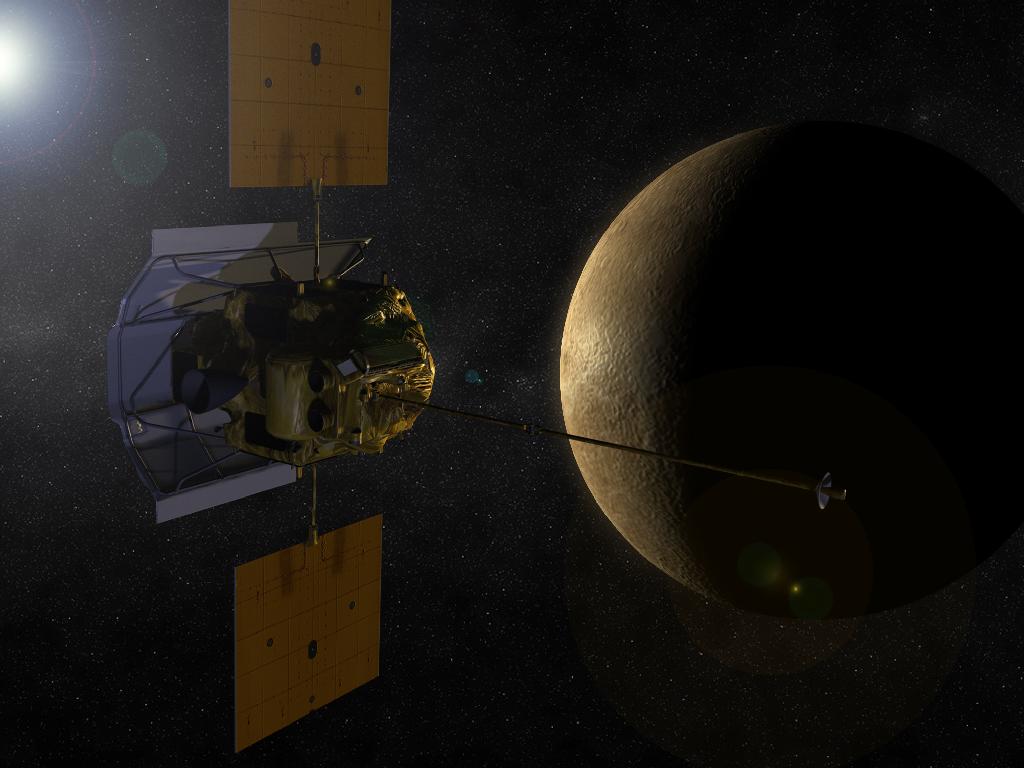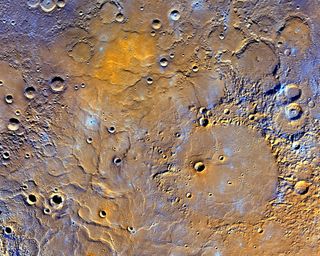Messenger: New Views of Mercury

MESSENGER was the first orbital mission around Mercury. More properly known as the MErcury Surface, Space ENvironment, GEochemistry, and Ranging mission, the more than 1,000-pound spacecraft checked out the sun's closest planetary neighbor and beamed back pictures as well as information about how craters and the mysterious landscape were formed — and even, how the planet itself might have come together. The mission came to an abrupt end on April 30, 2015, when the spacecraft, which had run out of fuel, crashed onto the planet's surface.
MESSENGER left Earth on Aug. 3, 2004, to take a complex path toward Mercury. Using a technique dating back to the Pioneer and Voyager missions, MESSENGER used the gravity of several worlds to slingshot it from place to place. That gave the spacecraft enough of a boost to arrive at Mercury and use the least fuel possible. This is important, as fuel is heavy to carry, increasing launch costs.
Dress rehearsal
The spacecraft swung by Earth on Aug. 2, 2005, to pick up speed, then aimed for Venus and did two flybys on Oct. 24, 2006, and June 5, 2007. When MESSENGER zipped by these worlds, NASA took the opportunity to turn on the cameras and instruments and get some data back, since they were in the neighborhood.
At Venus, for example, MESSENGER snapped 614 pictures. The imaging team then looked at the snapshots to make sure the colors were rendering properly and that the camera was working. Luckily, everything was looking just fine.
Flying by the clouded planet also provided a dress rehearsal for the crucial Mercury flybys; naturally, NASA wanted to make sure all was well on the spacecraft well ahead of arriving at the innermost planet. MESSENGER then did three flybys of Mercury between 2008 and 2009, which was intended to adjust its trajectory to settle into orbit in March 2011.
Scientists were excited by the prospect of mapping Mercury's unseen side, because only one U.S. spacecraft had flown by Mercury before. Although Mariner 10 was a capable spacecraft, its flybys in 1974 and 1975 had only mapped parts of the planet. There was much more for Mercury to show us.

Some of MESSENGER's objectives included finding out why Mercury is so dense compared to other planets, understanding Mercury's geologic history and its core, and how the planet's magnetic field works.
Even in the early months of orbiting Mercury, a wealth of new information flowed back to Earth. For example, MESSENGER found troves of sulfur on Mercury's surface, suggesting a couple of interesting things. Scientists believe Mercury's building blocks not only had less oxidization than other planets, but that the sulfur could reveal clues about Mercury's possible volcanic history. [Infographic: NASA's MESSENGER Mission to Mercury]
Additionally, MESSENGER began measuring the depths of craters around the north pole of Mercury, hunting for evidence that there could be spots in permanent shadow from the sun.
MESSENGER's primary mission to Mercury ended in March 2012, but the spacecraft's mission was extended twice. Part of scientists' motivation for extending the mission was to watch what happened at Mercury as the sun entered a solar maximum, when sunspots and solar activity would increase.
Cores and a 'curious' landscape
In 2012, MESSENGER discovered that Mercury's core is probably about 85 percent of its radius, which is an immense fraction compared to Earth's core, which is 50 percent of the planet's radius.
As Mercury does have a magnetic field, scientists believe the core must have some liquid in it (since liquid cores are believed to generate magnetic fields.) Still, the structure of Mercury's core is different from any other one known in the solar system. For one thing, there's a layer of solid iron sulfide lying over the planet's core.
NASA also released findings about Mercury's landscape, which it called a "curiosity." MESSENGER revealed a fairly smooth planet, with less elevation than observed on volcanic Mars or the moon.
The spacecraft's laser altimeter found a large area of lowlands high on the northern face of the planet, and also mapped out a large crater – Caloris Planitia, some 960 miles (1,550 kilometers) in diameter.
Divining water ice
MESSENGER was on a hunt for water ice, based on observations of very "radar-bright" deposits at both of Mercury's poles. The spacecraft found evidence that areas of the poles are in permanent shadow, which would provide the potential ice protection against the sun.
It's a smoking gun, but not definitive proof. NASA said it aimed to get more answers by combining pictures with observations from MESSENGER's laser altimeter and neutron spectrometer.
Even though MESSENGER was busy in Mercury's orbit, occasionally the scientists got some pictures of Earth — the spot where the spacecraft came from, and where it will never return.
In 2010, MESSENGER grabbed a shot of the Earth and the moon from 114 million miles (183 million km) away, a great deal farther away than the distance from the Earth to the sun (93 million miles, or 150 km.)
Later discoveries and work
In 2014, researchers using MESSENGER data uncovered evidence of vent explosions happening at the planet in different times in history. The article in the Journal of Geophysical Research, led by Brown University's Timothy Goudge, stated that researchers arrived at this conclusion because they saw different amounts of erosion on the vents. This implied they were formed at different times.
Meanwhile, data on water ice in the Prokofiev crater near Mercury's north pole released in 2014 showed that the surface ice was deposited on the planet after ice was placed on the craters underneath. Researchers are surprised by the discovery, since it appears water arrived more recently at the moon (a similar airless body to Mercury), but the reasons are still under investigation.
That year, MESSENGER temporarily moved to a new low of 62 miles (100 kilometers) above the planet, which the Johns Hopkins University Applied Physics Laboratory said would permit a better view of Mercury than ever before.
Demise
When it crashed, MESSENGER likely gouged a new crater into Mercury's heavily pockmarked surface. The 10-foot-wide (3 meters) spacecraft was traveling about 8,750 mph (14,080 km/h) at the time of impact, and it likely created a smoking hole in the ground about 52 feet (16 m) wide in Mercury's northern terrain, NASA officials said. No observers or instruments witnessed the crash, which occurred on the opposite side of Mercury from Earth. [Last Mercury Photos from NASA's MESSENGER]
Additional resources
Join our Space Forums to keep talking space on the latest missions, night sky and more! And if you have a news tip, correction or comment, let us know at: community@space.com.
Get the Space.com Newsletter
Breaking space news, the latest updates on rocket launches, skywatching events and more!

Elizabeth Howell (she/her), Ph.D., is a staff writer in the spaceflight channel since 2022 specializing in Canadian space news. She was contributing writer for Space.com for 10 years before joining full-time. Elizabeth's reporting includes multiple exclusives with the White House, speaking several times with the International Space Station, witnessing five human spaceflight launches on two continents, flying parabolic, working inside a spacesuit, and participating in a simulated Mars mission. Her latest book, "Why Am I Taller?" (ECW Press, 2022) is co-written with astronaut Dave Williams.